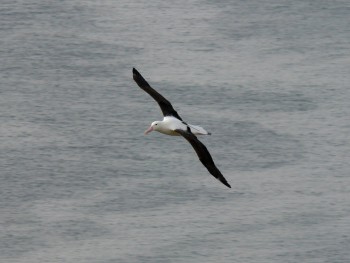Junichi Sugishita (Department of Zoology, University of Otago, Dunedin, New Zealand) and colleagues have published in the open-access journal Global Ecology and Conservation on at-sea tracking of Northern Royal Albatrosses Diomedea sanfordi feeding chicks in relation to the presence of fishing vessels.
The paper’s abstract follows:
“Incidental fisheries bycatch is recognised as a major threat to albatross populations worldwide. However, fishery discards and offal produced in large quantities might benefit some scavenging seabirds. Here, we demonstrate an integrated approach to better understand the ecological ramifications of fine-scale overlap between seabirds and fisheries. As a case study, we examined whether foraging in association with a fishing vessel is advantageous for chick provisioning in terms of quantity of food delivered to chicks, in northern royal albatross (Diomedea sanfordi) at Taiaroa Head, New Zealand. Fine-scale overlap between albatrosses and vessels was quantified by integrating GPS tracking and Vessel Monitoring Systems (VMS). Meal size delivered to chicks was measured using custom-designed nest balances, and monitoring of attendance of adults fitted with radio transmitters was used in conjunction with time-lapse photography at the nest allowed us to allocate each feeding event to a specific parent. The combination of these techniques enabled comparison of meal sizes delivered to chicks with parental foraging trip durations with or without fishing vessels association. A total of 45 foraging trips and associated chick feeding events were monitored during the chick-rearing period in 2012. Differences in the meal size and foraging trip duration relative to foraging overlap with fisheries were examined using a linear mixed-effect model, adjusted for chick age. Our results, based on three birds, suggest that foraging in association with vessels does not confer an advantage for chick feeding for this population that demonstrated low rates of overlap while foraging. The integrated research design presented can be applied to other seabird species that are susceptible to bycatch, and offers a valuable approach to evaluate habitat quality by linking habitat use and foraging success in terms of total amount of food delivered to offspring.”

A Northern Royal Albatross bears a GPS tracking system

A Northern Royal Albatross feeds its chick sitting on a nest balance
Photographs by Junichi Sugishita
With thanks to Junichi Sugishita for information and photographs.
Reference:
Sugishita, J., Torres, L.G. & Seddon, P.J. 2015. A new approach to study of seabird-fishery overlap: connecting chick feeding with parental foraging and overlap with fishing vessels. Global Ecology and Conservation 4: 632-644.
John Cooper, ACAP Information Officer, 05 December 2015

 English
English  Français
Français  Español
Español